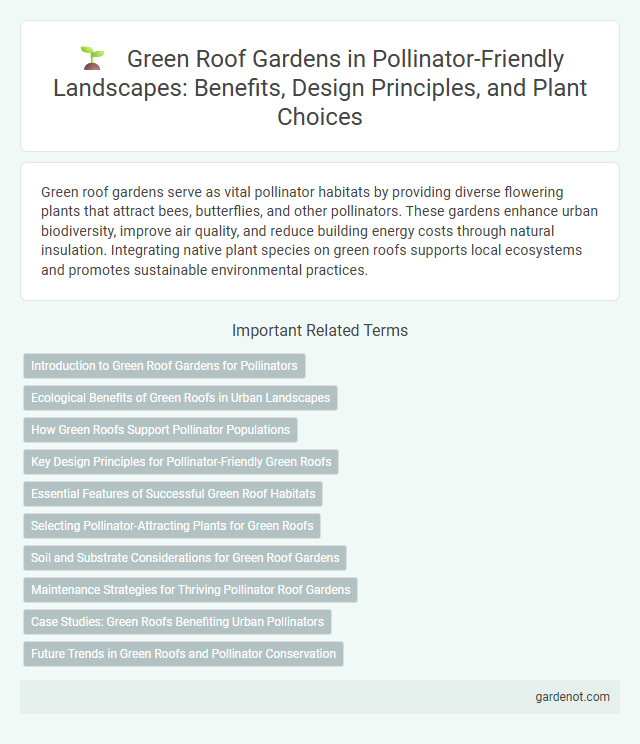Green roof gardens serve as vital pollinator habitats by providing diverse flowering plants that attract bees, butterflies, and other pollinators. These gardens enhance urban biodiversity, improve air quality, and reduce building energy costs through natural insulation. Integrating native plant species on green roofs supports local ecosystems and promotes sustainable environmental practices.
Introduction to Green Roof Gardens for Pollinators
Green roof gardens provide essential habitats for pollinators by offering diverse flowering plants and nesting spaces in urban environments. These gardens improve biodiversity, support bees, butterflies, and other pollinating insects, and help mitigate urban heat island effects. Incorporating native plants and ensuring continuous bloom cycles maximize the ecological benefits for pollinator populations.
Ecological Benefits of Green Roofs in Urban Landscapes
Green roof gardens provide critical ecological benefits in urban landscapes by enhancing biodiversity, supporting pollinators such as bees and butterflies, and improving air quality. These green spaces reduce urban heat island effects by absorbing sunlight and cooling the surrounding environment, while stormwater management is improved through natural water retention and filtration. Implementing green roofs promotes habitat connectivity and resilience for pollinator populations amidst increasing urbanization.
How Green Roofs Support Pollinator Populations
Green roofs serve as vital habitats for pollinators by providing diverse flowering plants that offer nectar and pollen throughout the growing season. Their elevated location reduces exposure to ground-level pesticides and habitat fragmentation, enhancing pollinator survival and reproduction rates. Studies show that green roofs can increase local pollinator diversity, supporting essential ecosystem services in urban environments.
Key Design Principles for Pollinator-Friendly Green Roofs
Green roof gardens designed for pollinators prioritize native flowering plants that provide continuous bloom cycles, ensuring a steady nectar and pollen supply. Incorporating diverse plant species with varied heights and flower structures supports a wide range of pollinator species, enhancing biodiversity. Adequate soil depth and water retention systems are essential to sustain plant health and attract pollinators throughout seasonal changes.
Essential Features of Successful Green Roof Habitats
Successful green roof habitats for pollinator gardens require lightweight, well-draining substrate to support diverse plant species and prevent waterlogging. Incorporating native flowering plants ensures continuous nectar and pollen sources essential for pollinators like bees and butterflies. Structural elements such as windbreaks and moisture-retentive materials enhance habitat stability and resilience against harsh rooftop conditions.
Selecting Pollinator-Attracting Plants for Green Roofs
Selecting pollinator-attracting plants for green roof gardens involves prioritizing native, drought-tolerant species such as lavender, milkweed, and coneflower that thrive in shallow soil and high sun exposure. These plants provide essential nectar and pollen sources for bees, butterflies, and hummingbirds, enhancing urban biodiversity and supporting pollination. Incorporating diverse flowering plants with staggered bloom times ensures continuous food supply and habitat for pollinators throughout the growing season.
Soil and Substrate Considerations for Green Roof Gardens
Selecting lightweight, well-draining soil substrates with high organic matter content is crucial for green roof gardens to support pollinator-friendly plants. Incorporating materials such as expanded clay, perlite, or vermiculite enhances aeration and moisture retention while reducing overall weight. Proper substrate composition ensures optimal root development and sustains diverse pollinator habitats on elevated garden spaces.
Maintenance Strategies for Thriving Pollinator Roof Gardens
Effective maintenance strategies for thriving pollinator roof gardens include regular monitoring of plant health and soil moisture to ensure optimal growing conditions. Incorporating native flowering plants that bloom sequentially supports continuous nectar and pollen availability throughout the season. Implementing integrated pest management and avoiding chemical pesticides preserves beneficial pollinator populations on green roof gardens.
Case Studies: Green Roofs Benefiting Urban Pollinators
Green roof gardens provide critical habitats for urban pollinators by increasing floral diversity and availability of nectar sources in city environments. Case studies reveal that green roofs with native flowering plants significantly boost populations of bees, butterflies, and other pollinators, enhancing urban biodiversity. These rooftop ecosystems also improve pollination services for nearby green spaces and support ecological resilience amidst urbanization.
Future Trends in Green Roofs and Pollinator Conservation
Green roof gardens are evolving to incorporate advanced technologies that enhance habitat suitability for pollinators, integrating native flowering plants specifically selected for their nectar and pollen availability. Future trends in green roofs emphasize multifunctional ecosystems that support biodiversity, improve urban microclimates, and contribute to pollinator conservation by providing continuous floral resources throughout the growing season. Innovations such as modular green roof systems and sensor-based irrigation optimize plant health and sustainability, reinforcing the role of green roofs as vital urban pollinator habitats.
Green roof garden Infographic

 gardenot.com
gardenot.com